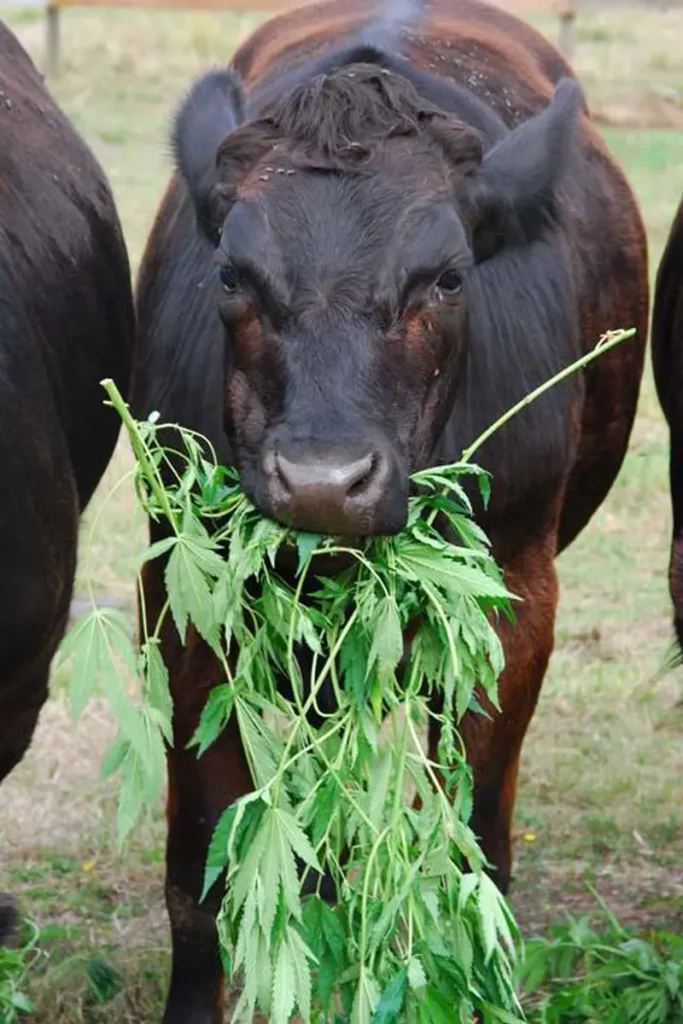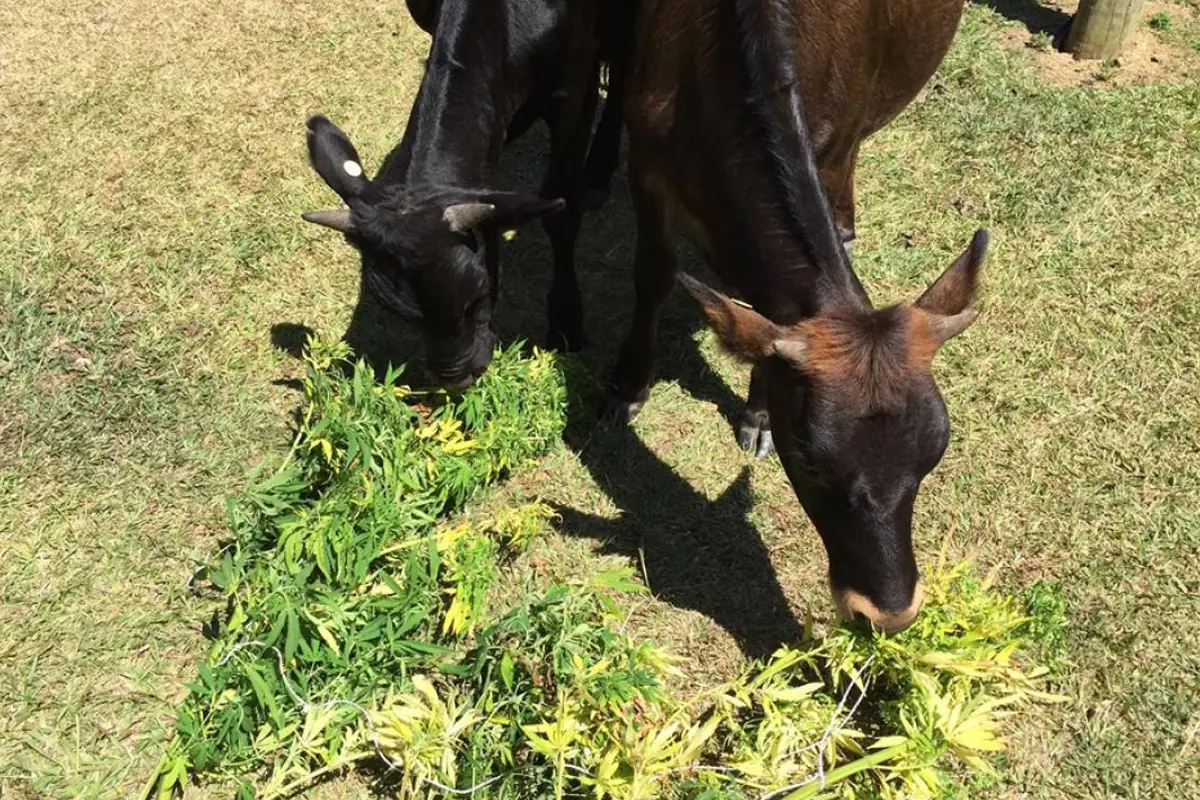Regulatory concerns arise with the integration of hemp in livestock nutrition. A promoter of sustainable agricultural practices? Scientific research results show C02 reduction
Introducing industrial hemp in livestock applications – are conventional agricultural sources no longer sustainable? The research Industrial Hemp: Food and Nutraceutical Applications
The conventional protein sources commonly used in livestock nutrition, such as soybean meal, canola meal, or fish meal, are no longer sustainable due to increasing prices. Consequently, there’s a growing need for new and sustainable protein sources for animal feeds, such as industrial hemp.
The research Industrial Hemp: Food and Nutraceutical Applications (2022) suggests that supplementing ruminant animal diets with industrial hemp seeds or by-products could enhance the nutritional quality of milk and dairy products by increasing lactose and fatty acids. Conversely, for poultry nutrition, incorporating extracts of bioactive substances like cannabidiol or hemp oil into diets appears more suitable than adding expellers or other hemp processing by-products.
Improving the health and meat quality of livestock by feeding them hemp-based pellets – The case of Raintree farm, Western Australia
Cattle and marron at Raintree farm on Western Australia’s south coast are being nourished with hemp-based pellets as part of an experimental initiative aimed at enhancing their well-being and the quality of their meat. The Raintree Estate, home to a licensed hemp crop primarily for producing spirits, utilizes the by-product from the distillation process in pellet form.
The trial involves utilizing a by-product from hemp distillation for alcohol to create pellets for feeding cattle and marron.
The independent study involves feeding hemp pellets to nine Angus-Wagyu cross cattle, while a control herd consumes different pasture fodder. These experiments, as assured by veterinarians, prioritize animal welfare and adhere to regulatory standards to ensure safety for both animals and consumers.
While the hemp industry has been growing, current regulations restrict the use of industrial hemp as livestock forage due to concerns about THC transfer from animals to humans. There are hopes for regulatory developments to support its broader use in agriculture.
Raintree Farm – a new source among agricultural raw materials for livestock nutrition. Hemp nutritional benefits
Hemp offers various benefits for livestock health, including high nutritional value, natural antioxidants, balanced omega fatty acids, and high protein content.
The director of the Raintree farm participating in the initiative anticipates positive outcomes due to hemp’s nutritional richness, including decreased cholesterol levels in animals and healthier meat products for human consumption.
Hemp can be incorporated into the diets of various livestock types, such as poultry, swine, ruminants, equine, and aquaculture species. The main proteins in hemp seeds are edestin and albumin, and a decent amount of essential amino acids. Additionally, hemp seeds are rich in arginine, glutamic acid, methionine, and cystine. Hemp oil, which is extracted from the seeds, is predominantly composed of polyunsaturated fatty acids, with linoleic acid and α-linoleic acid being the primary essential fatty acids.
After removing the lipid fraction, hemp cakes or meals can be produced, which are rich in protein and have reduced lipid content compared to whole hemp seeds. Hemp seeds and hemp seed cakes also contain tocopherols, particularly γ-tocopherol, contributing to their nutritional profile.

What are the implications of feeding hemp to livestock? Oregon State University investigation on hemp biomass to serve as a viable animal feed
Researchers at Oregon State University (OSU), collaborating with the school’s Global Hemp Innovation Center, are investigating whether this leftover hemp biomass can serve as a viable feed for sheep, dairy cows, and poultry.
Currently, Oregon’s hemp industry primarily produces two cannabidiol (CBD) products: hemp oil and a specialized smokable flower. However, the process of extracting CBD oil leaves behind parts of plant material, known as biomass, which currently holds little value.
Despite the challenges faced by Oregon’s hemp industry since its legalization in 2018, including oversupply and market saturation, there is optimism about the potential secondary market for hemp biomass. Preliminary results from OSU’s trials show promising signs, with hemp biomass demonstrating comparable or even superior performance to traditional feed in terms of animal health and productivity.
While THC levels in the hemp-fed animals were minimal, regulatory approval from the U.S. Food and Drug Administration (FDA) is necessary to ensure safety for human consumption.
Hemp as livestock feed represents a potential opportunity to reduce feed costs, grain supply, and improve the sustainability of agricultural production
The research into hemp as livestock feed represents a potential opportunity to reduce feed costs and improve the sustainability of hemp production.
Responding to this call, Dr. Negusse Kidane, an assistant professor and research scientist at Prairie View A&M University’s College of Agriculture, Food, and Natural Resources (CAFNR), has proposed a study titled “Evaluating the Nutritional Profile of Industrial Hemp Farm-Byproducts and Extraction Residues as Alternative Feed Resources for Goats”. Dr. Kidane aims to investigate whether biomass from hemp plants could serve as a viable alternative to grain in animal feed, given that animal feed currently consumes approximately 36% of the world’s grain supply. His research will assess the nutritional profile of industrial hemp plant biomass byproducts and their impact on goats, with the objective of determining if hemp biomass can effectively reduce the reliance on grain in animal feed.
Hemp, like grain, has a long history, but its cultivation faced legal restrictions until the 2018 Farm Bill legalized it, opening opportunities for growers, ranchers, processors, and agricultural scientists. In Texas, recent legislation further legalized hemp production, leading to a growing number of farmers and processors in the state.
Optimal animal health equals lower carbon emissions. The role of hemp in targeting methane reduction
Nutrition plays a vital role in mitigating emissions generated by livestock, since good nutrition enhances animals’ natural immune systems, promotes better health and increases productivity. This, in turn, allows farmers to meet demand with fewer animals, thereby reducing greenhouse gas emissions.
When tallow, sunflower oil, or whole sunflower seeds were introduced into the diet of Angus heifers, methane emissions decreased by approximately 14% with tallow or sunflower oil and by 33% with sunflower seeds. The alternative was to incorporate food by-products like sugar beet molasses into animal feed, and that as well has shown to lower emissions by reducing reliance on energy-intensive grain crops.
At the current state, only two studies have assessed the inhibition of in vitro ruminal nitrogen and methane production using hemp seed by-products. Results from these studies indicate that both whole hemp seed and its hemp oil have neutral effects on ruminal ammonia-nitrogen production. Compared to linseed, whole hemp demonstrated an 8% greater effectiveness in reducing methane, while it showed comparable effectiveness to coconut oil. It was observed a 10% reduction in methane production with hemp oil compared to corn oil. The reduction in methane production is attributed to the high content of polyunsaturated fatty acids in hemp seed oil, which suppress protozoa and act as a sink for hydrogen through biohydrogenation.
A decrease in methane concentration may reduce atmospheric greenhouse gasses
Whole hemp seed is more effective than oil in inhibiting methanogens because it contains more terpenes, polyphenols, and lignans, which are more toxic to methanogens than polyunsaturated fatty acids. These compounds accumulate in cytoplasmic membranes as they are lipophilic, thus disrupting methanogen cell membranes.
While methane production maintains the redox balance of the ruminal environment by providing a pathway for excess pyruvate, it reduces the amount of metabolizable energy obtained from the diet, consequently increasing the energy required for meat production. A decrease in methane concentration may reduce atmospheric greenhouse gasses and enhance feed utilization efficiency, as methane emissions represent approximately 10% of gross energy loss from feed intake.
Hemp triggering alterations in the behavior and health of the animals? Scientific research makes legal framework wary to allow the presence of hemp in livestock nutrition
A team led by the German Federal Institute for Risk Assessment (BfR) conducted research on the effects of incorporating hemp silage into dairy cow diets, focusing on silage, a form of preserved animal feed. Published in Nature Food, their study revealed that elevated levels of cannabinoids in hemp silage led to noticeable changes in the behavior and health of the cows. These changes included reduced appetite, decreased milk production, slower breathing and heart rates, drowsiness, and instability.
Dr. Robert Pieper, a BfR feed expert and co-author of the study, wrote that even a small amount of hemp silage in the daily feed of dairy cows resulted in cannabinoids, including Δ9-THC, being present in the milk. The adverse effects on animal health were linked to the cannabinoid levels in the silage, influenced by various factors. This research stemmed from concerns raised in the EU over a decade ago regarding the potential transfer of cannabinoids from hemp fed to cows into their milk.
To address these concerns, the BfR initiated investigations in 2016: the study involved ten dairy cows and measured cannabinoid content in milk, blood plasma, and feces, while also monitoring physiological functions and observing behavioral changes. Initially, cows were fed hemp silage with minimal cannabinoid concentrations, showing no health impacts. However, when cows were given silage with higher cannabinoid levels, sourced from leaves, flowers, and hemp seeds, behavioral changes were noted, along with detectable amounts of Δ9-THC and other cannabinoids in the milk.
Seeing such levels of cannabinoids contained in milk and the potential health implications of consuming the derived products, particularly for children, many countries are wary of approving the legal framework to allow the presence of hemp in all of its forms in livestock nutrition.
Raintree Farm, Australia
Raintree Farm is a mixed farming enterprise including industrial hemp. A multifaceted agricultural enterprise, Raintree sustains a herd of more than 200 black Angus cattle while also cultivating over eight acres of Cannabis sativa (hemp) each year.



















